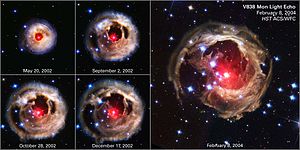Portal:Stars
IntroductionA star is a luminous spheroid of plasma held together by self-gravity. The nearest star to Earth is the Sun. Many other stars are visible to the naked eye at night; their immense distances from Earth make them appear as fixed points of light. The most prominent stars have been categorised into constellations and asterisms, and many of the brightest stars have proper names. Astronomers have assembled star catalogues that identify the known stars and provide standardized stellar designations. The observable universe contains an estimated 1022 to 1024 stars. Only about 4,000 of these stars are visible to the naked eye—all within the Milky Way galaxy. A star's life begins with the gravitational collapse of a gaseous nebula of material largely comprising hydrogen, helium, and trace heavier elements. Its total mass mainly determines its evolution and eventual fate. A star shines for most of its active life due to the thermonuclear fusion of hydrogen into helium in its core. This process releases energy that traverses the star's interior and radiates into outer space. At the end of a star's lifetime as a fusor, its core becomes a stellar remnant: a white dwarf, a neutron star, or—if it is sufficiently massive—a black hole. Stellar nucleosynthesis in stars or their remnants creates almost all naturally occurring chemical elements heavier than lithium. Stellar mass loss or supernova explosions return chemically enriched material to the interstellar medium. These elements are then recycled into new stars. Astronomers can determine stellar properties—including mass, age, metallicity (chemical composition), variability, distance, and motion through space—by carrying out observations of a star's apparent brightness, spectrum, and changes in its position in the sky over time. Stars can form orbital systems with other astronomical objects, as in planetary systems and star systems with two or more stars. When two such stars orbit closely, their gravitational interaction can significantly impact their evolution. Stars can form part of a much larger gravitationally bound structure, such as a star cluster or a galaxy. (Full article...) Selected star - Photo credit: User:Dbenbenn and User:Qef
Alpha Centauri (α Centauri / α Cen); (also known as Rigil Kentaurus, Rigil Kent, or Toliman) is the binary star system Alpha Centauri AB (α Cen AB), of which Alpha Centauri A (α Cen A) is the brightest star in the southern constellation of Centaurus. To the unaided eye it appears as a single star, whose total visual magnitude would identify it as the third brightest star in the night sky. Alpha Centauri AB is 1.34 parsec or 4.37 light years away from our Sun. The two stars are the closest stars to the Sun after their companion Proxima Centauri, at 0.21 light-year away from the two, and at 4.243 light-years away from the Sun. At −0.27v visual magnitude, Alpha Centauri appears to the naked-eye as a single star and is fainter than Sirius and Canopus. The next brightest star in the night sky is Arcturus. When considered among the individual brightest stars in the sky (excluding the Sun), Alpha Centauri A is the fourth brightest at −0.01 magnitude being only fractionally fainter than Arcturus at −0.04v magnitude. Alpha Centauri B at 1.33v magnitude is twenty-first in brightness. Selected article - Photo credit: NASA
A variable star can be classifies when its apparent magnitude as seen from Earth changes over time, whether the changes are due to variations in the star's actual luminosity, or to variations in the amount of the star's light that is blocked from reaching Earth. Many, possibly most, stars have at least some variation in luminosity: the energy output of our Sun, for example, varies by about 0.1% over an 11 year solar cycle, equivalent to a change of one thousandth of its magnitude. It is convenient to classify variable stars as belonging to one of two types:
The first variable star was identified in 1638 when Johannes Holwarda noticed that Omicron Ceti (later named Mira) pulsated in a cycle taking 11 months; the star had previously been described as a nova by David Fabricius in 1596. This discovery, combined with supernovae observed in 1572 and 1604, proved that the starry sky was not eternally invariable as Aristotle and other ancient philosophers had taught. In this way, the discovery of variable stars contributed to the astronomical revolution of the sixteenth and early seventeenth centuries. Variable stars are generally analysed using photometry, spectrophotometry and spectroscopy. Measurements of their changes in brightness can be plotted to produce light curves. For regular variables, the period of variation and its amplitude can be very well established; for many variable stars, though, these quantities may vary slowly over time, or even from one period to the next. Peak brightnesses in the light curve are known as maxima, while troughs are known as minima. Selected image - Photo credit: commons:User:Pbroks13
An illustration of the structure of the Sun:
1. Core 2. Radiative zone 3. Convective zone 4. Photosphere 5. Chromosphere 6. Corona 7. Sunspot 8. Granules 9. Prominence Did you know?
SubcategoriesTo display all subcategories click on the ►
Selected biography - Photo credit: Portrait from Toruń
Nicolaus Copernicus (19 February 1473 – 24 May 1543) was the first astronomer to formulate a comprehensive heliocentric cosmology, which displaced the Earth from the center of the universe. Nicolaus Copernicus was born on 19 February 1473 in the city of Toruń (Thorn) in Royal Prussia, part of the Kingdom of Poland. Copernicus' epochal book, De revolutionibus orbium coelestium (On the Revolutions of the Celestial Spheres), published just before his death in 1543, is often regarded as the starting point of modern astronomy and the defining epiphany that began the scientific revolution. His heliocentric model, with the Sun at the center of the universe, demonstrated that the observed motions of celestial objects can be explained without putting Earth at rest in the center of the universe. His work stimulated further scientific investigations, becoming a landmark in the history of science that is often referred to as the Copernican Revolution. Among the great polymaths of the Renaissance, Copernicus was a mathematician, astronomer, physician, quadrilingual polyglot, classical scholar, translator, artist, Catholic cleric, jurist, governor, military leader, diplomat and economist. Among his many responsibilities, astronomy figured as little more than an avocation – yet it was in that field that he made his mark upon the world.
TopicsThings to do
Related portalsAssociated WikimediaThe following Wikimedia Foundation sister projects provide more on this subject:
Discover Wikipedia using portals |


























